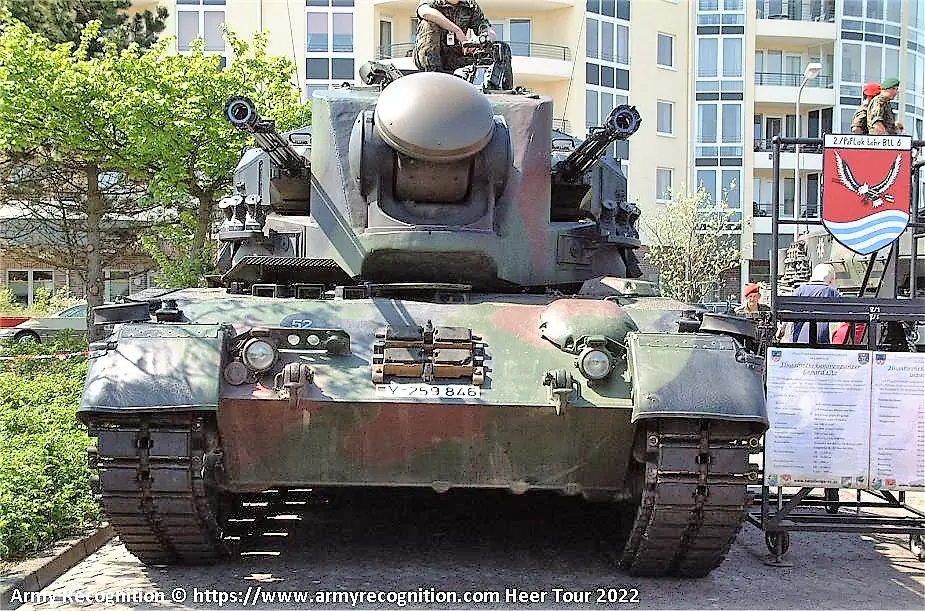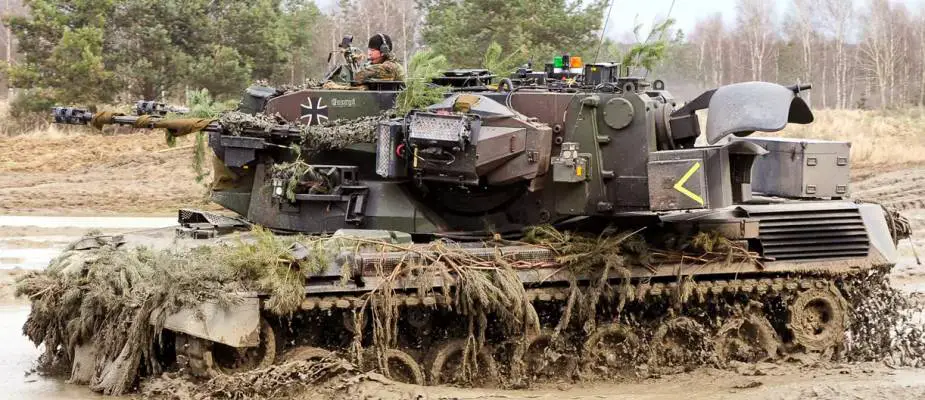The German Federal Government will equip Ukraine with 50 anti-aircraft tanks of the Gepard type, von Bjorn Müler writes in Wir sind die Reserve. This was announced by Defense Minister Christine Lambrecht (SPD) at the meeting of the "Ukraine Security Consultative Group" at the US base in Ramstein. The Consultative Group is a platform created by the USA to coordinate arms assistance among the Western powers, primarily the NATO countries.
Follow Army Recognition on Google News at this link

German army Gepard 35mm anti-aircraft tank (Picture source: Army Recognition)
The Gepard anti-aircraft tank has not been used in the Bundeswehr for more than ten years. The Federal Government approved the export of stock from the Gepard manufacturer Krauss-Maffei-Wegmann (KMW) which has offered 50 units for sale to Ukraine. When asked why Germany was only now approving the delivery of the Gepards, Defense Minister Christine Lambrecht responded in Ramstein with the evasive formula: "We are constantly checking and acting in constant coordination with our allies."
The Gepard was introduced into the Bundeswehr at the beginning of the 1970s for mobile air defense at close range. It is designed to accompany tank formations in battle and shield them from air attacks by crushing attacks from helicopters and fighter planes. The turret is armed with twin 35mm guns that can fire different types of ammunition at high rates. The Cold War Bundeswehr was designed as a tank army able to delay a massive Russian attack. So, strong mobile anti-aircraft defenses were considered essential. It ensured that the tanks could engage in ground combat without being quickly destroyed from the air. Such a battle scenario now faces the Ukrainians in the vastness of the Donbas and elsewhere when it comes to countering massive advances by Russian mechanized forces with their tanks and IFVs.
According to the annual report Military Balance 2021, the Ukrainian army still had 75 Tunguska anti-aircraft tanks - the Soviet equivalent of the Gepard - at the beginning of the war. The number of casualties is not known. What is clear is that the longer the war lasts, the Ukrainians' resources and opportunities to deploy their post-Soviet military technology will rapidly diminish. The country's largest tank production and repair facility is located in the hard-fought Kharkiv.
However, the Gepards do not pose a threat to the Russian spring offensive. The training of teams, including technicians, plus the development of a logistics chain will take several months. Here the equipment of Romania with Gepard anti-aircraft tanks in the early 2000s provides an orientation. By 2004, the Romanian Armed Forces received 43 Gepards of the older B2L series. Today, they form two anti-aircraft battalions, one assigned to each of Romania's two army divisions.
Senior Staff Sergeant a. D Wolfgang Sommer was the planner and head of training for the Romanian regular crews. Between 1999 and 2000, he and his team of four sergeants with interpreters trained around 27 Romanian army soldiers on the Gepard. Sommer in an interview said: “After the compact driver training came the operator training. This lasted nine months. At the same time, an infrastructure was set up in Turda, Romania, with shelters and workshops”. Officers were trained as commanders and non-commissioned officers as drivers and operators of the weapon system and as repairers for this and the electronics. “It was an advantage that the Romanians were still craftsmen at the time. That means there was a basic technical understanding. I doubt if that would still be the case today.”
The center of education and training was the Putlos military training area with its own halls for three training Gepards including repairs plus simulators. “At that time, the training project was strongly supported by the management of the military department. We could draw on the full: obtaining practice sites was uncomplicated. Ammunition was plentiful.”

German army Gepard 35mm anti-aircraft tank (Picture source: KMW)
Training the Ukrainians would take 2 to 5 months
Work was often carried out around the clock in shifts. The starting point was a completely disassembled Gepard on which the technology was explained. Then they learned in small groups on so-called "stations". For example, how to eliminate various faults on the tank, helicopter launch on the simulator or real flight target engagement with the help of target display aircraft such as a Learjet. In the evening there were German courses for the Romanians. Practical training for movement in combat and field repairs was also essential, says Sommer. "In terms of drills, the nine months were just enough."
Sommer estimates that it will take at best six months of training and technical preparation for the Ukrainians to be able to use the anti-aircraft tank in a meaningful way. According to the Gepard expert, this would be particularly demanding for the Ukrainian army. The Bundeswehr recently used the “cheetahs” in a combat system. A distant radar distributed target coordinates to the individual anti-aircraft tanks. Both anti-aircraft reconnaissance and fire control transmitted the data in encrypted form. The "cheetahs" thus no longer had to use their own radar to detect opponents, which made their detection by radar radiation more difficult. In such a system, the Ukrainians cannot use their "cheetahs", but only with their own active radar, which makes them more vulnerable.
Markus Richter also sees a future Gepard mission by the Ukrainians with special challenges. Richter is a former instructor on the Gepard and a specialist in anti-aircraft. He is known as "cheetah paw" (cheetah means Gepard) on Twitter, where he analyzes anti-aircraft issues. According to Richter, routine drills would be crucial for a high operational value of the Gepard in the Donbas. "If a crew in combat takes too long to eliminate a mistake because they lack the experience, there is a great danger that the weapon system will have to be abandoned." But there is only routine through constant practice drives and maneuvers, for those in the dynamics of war the time is missing.
Richter believes that the Ukrainian Gepards can be ready for action in two to five months. Two months would be ideal. “Here, however, all factors have to mesh optimally. That means training with motivated Ukrainian anti-aircraft soldiers who have already mastered the operational principles of their equipment, as well as rapid technical preparation by the industry", says Gepard specialist Richter. Training via the Bundeswehr is no longer an option because there is now a lack of competence, General Inspector Eberhard Zorn made clear in the podcast “From Government Circles”.
When it comes to the technical preparation of the mothballed anti-aircraft tanks, the devil is often in the details. The input mask of the control panel at the Gepard, which are intended for the Ukrainians, is in German. As for Qatar or other customers, this must first be adjusted by KMW. Richter hopes that the Ukrainians will take part in vehicle preparation at KMW. "That would speed up the training on the technology." It will also be interesting to see whether Romania, as the last Gepard operator in NATO, will make its repair capacities available to the Ukrainians or even set up a maintenance point near the border.














